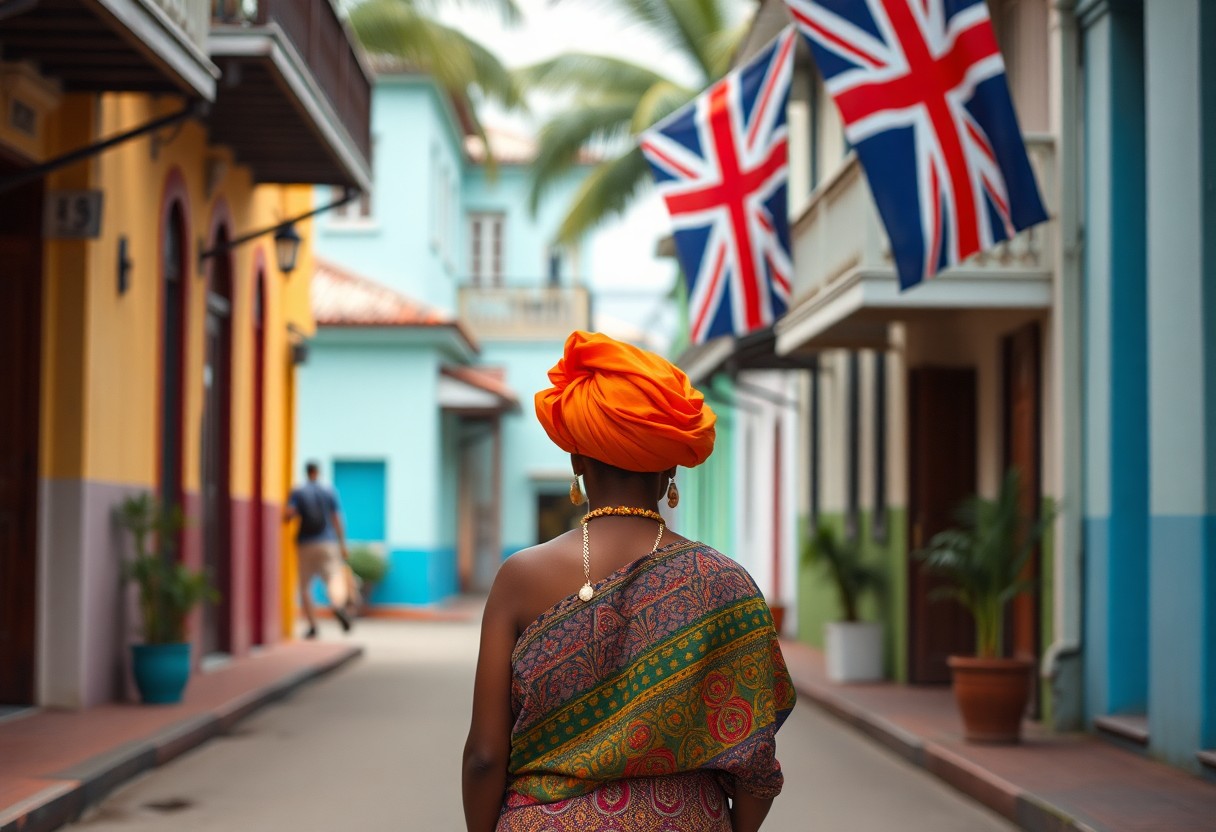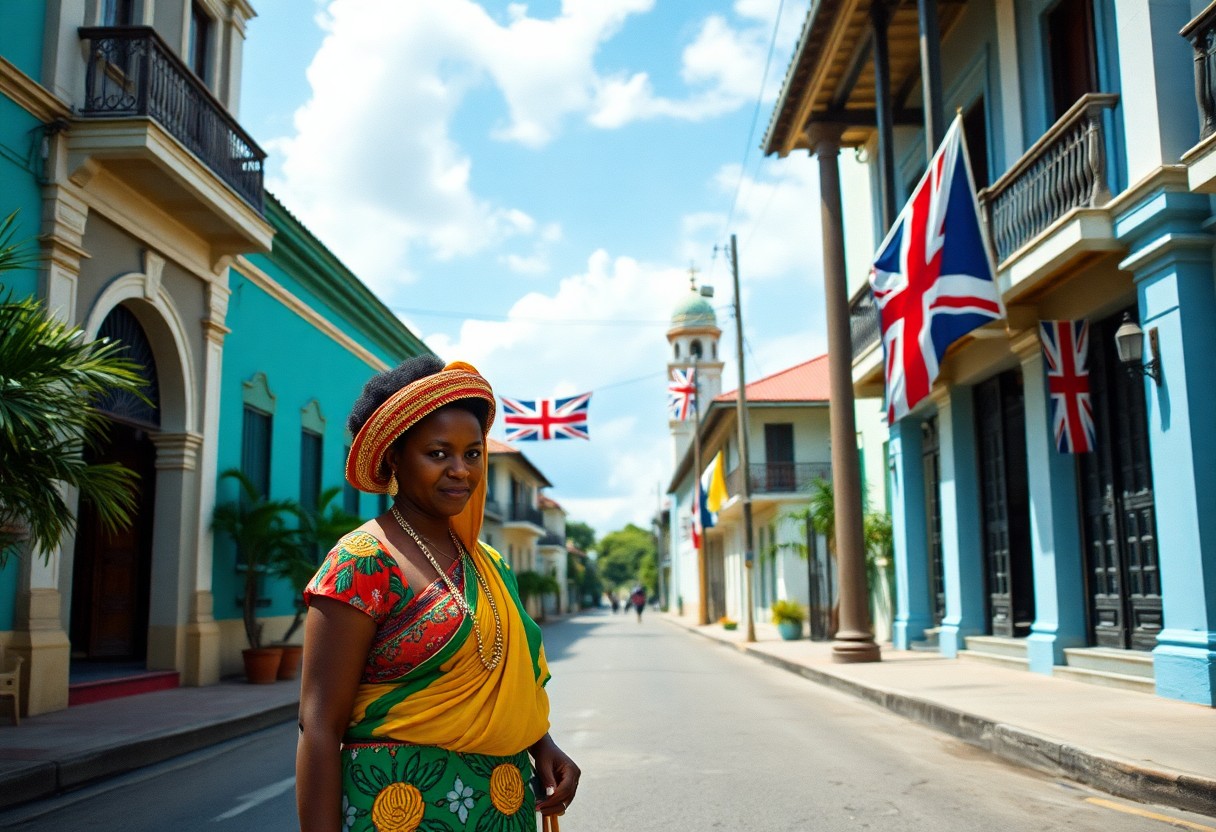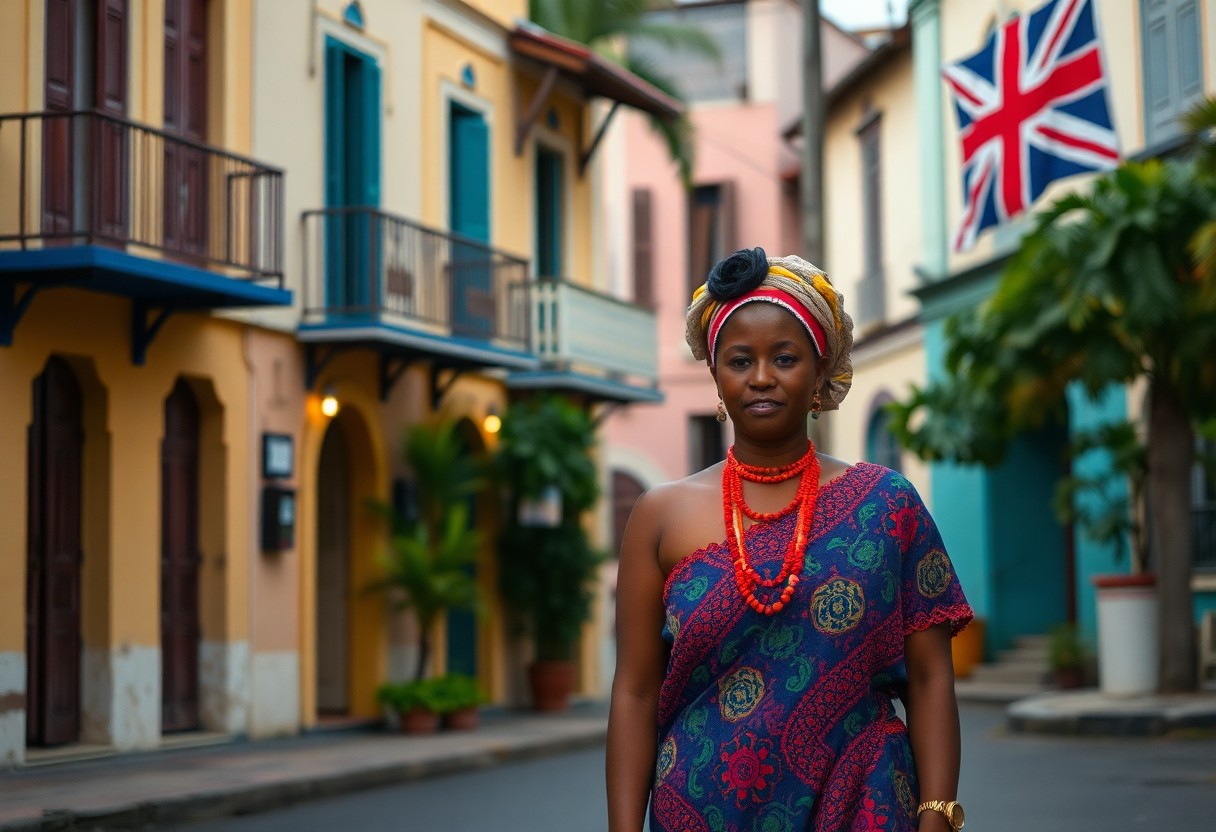Belize proudly boasts a distinctive linguistic heritage, standing out as the only English-speaking country in Central America. This unique status is deeply rooted in its rich historical tapestry and the British colonial influence that has significantly shaped the nation’s cultural and linguistic identity over centuries. As you explore Belize’s historical narrative, you will uncover the substantial contributions of British settlers, commonly referred to as Baymen, who established their presence in the region during the 17th and 18th centuries. Their transformative impact led to a remarkable evolution of local culture and language. The formal designation of British Honduras not only reinforced English as the official language but also solidified a distinctive linguistic identity that sets Belize apart from its predominantly Spanish-speaking neighbours.
Unpacking the Historical Context of Belize’s Language Development
The linguistic evolution of Belize can be traced back to its intricate colonial history, which is rich with diverse influences that have shaped its present-day identity. The English-speaking character of Belize arises from a unique amalgamation of British colonialism, interactions with local indigenous populations, and maritime trade relationships. As you navigate through the historical timeline of Belize, you will witness how British intervention significantly shaped the nation’s cultural and linguistic development, transforming a once-territorial region into a vibrant nation with a distinct identity.
Exploring the Transformative Effects of the British Colonial Era
Beginning in the early 17th century, British settlers initiated a profound transformation of the linguistic landscape in Belize. You will see how British logwood traders and settlers gradually adopted English as the primary language for administration and commerce. Their economic pursuits, particularly in timber extraction and later agricultural ventures, systematically integrated English into local communication, fundamentally altering the trajectory of Belize’s linguistic evolution. This pivotal shift laid a solid foundation for English to flourish across the region, embedding it deeply within the fabric of Belizean society.
Significant Milestones on the Journey to Independence
The timeline charting Belize’s journey toward independence encompasses numerous pivotal decades, reflecting a series of significant milestones that span from the era of British colonial governance to achieving sovereign nationhood in 1981. Among these milestones are progressive constitutional changes, including the self-governance period that commenced in 1964 and the subsequent negotiations for independence. These developments represent a strategic transition that ensured the continued prominence of English as the official language, reinforcing its critical role in the nation’s identity.
A Comprehensive Examination of Independence and Its Implications
A closer examination of Belize’s path to independence reveals a nuanced political transformation. You will gain insight into how peaceful negotiations with the United Kingdom facilitated a smooth transition to self-governance. Throughout this transformative period, Belize retained strong linguistic and administrative ties to British systems, significantly shaping its continued use of English. This understanding highlights how Belize adeptly harnessed its colonial heritage to forge a distinct national identity while progressing toward independence.
The Role of English in Shaping Colonial Education Systems
As you delve into the linguistic framework of Belize, you will come to appreciate that British colonial education policies played a crucial role in shaping the country’s language dynamics. The British established English as the primary language of instruction, creating a strategic educational framework that permanently altered Belize’s cultural communication. This system ensured that English became the dominant medium of learning, effectively transforming the educational landscape for countless generations of Belizeans and embedding the language into the very core of Belizean society.
The Establishment of Educational Institutions Under British Rule
In Belize, educational institutions were developed under direct British colonial oversight, with missionary schools playing a vital role in transmitting both language and culture. These early educational establishments were not merely places for academic learning; they were purposefully designed to propagate English linguistic norms. The British strategically established schools that prioritised English language instruction, fostering a structured educational environment that gradually diminished the use of indigenous languages, thus reshaping the linguistic landscape of Belize.
Rising Literacy Rates and Enhanced Language Proficiency
Throughout your exploration, you will observe that English literacy rates in Belize experienced substantial growth during the colonial periods. By the mid-20th century, around 75% of the population had developed functional English language skills, illustrating the effectiveness of the comprehensive educational initiatives implemented by British authorities. This transition was not merely an academic achievement; it represented a profound cultural transformation that reshaped the identity of Belizean society, intertwining language with social mobility and economic advancement.
Learning English became a significant tool for social mobility and economic progress. You will understand that language acquisition transcended mere educational goals; it symbolised a pathway to greater opportunities. The British colonial system effectively tied English proficiency to professional advancement, incentivising Belizeans to learn the language. Mastery of English opened doors to improved employment prospects, administrative roles, and elevated social status, making language an essential mechanism for cultural and economic integration within the society.
Examining the Contrast Between Official Language and Local Dialects
As you delve deeper into Belize’s linguistic landscape, you will discover that the dynamics are intricate and multifaceted. While English holds the status of the official language, the nation’s communication is enriched by a diverse tapestry of cultural influences. You’ll find that, despite its colonial roots, language in Belize is not merely a binary phenomenon; it is a dynamic interplay of historical and social forces that shape communication across various communities, highlighting the nation’s rich heritage.
The Significance of English in Belizean Society
Beyond its official designation, English serves as the primary language for government, education, and media. It is noteworthy that approximately 63% of the population utilises English as either their first or second language, highlighting its entrenched importance in Belizean society. This linguistic predominance is a direct result of the nation’s British colonial legacy, and it continues to play a critical role in defining the Belizean national identity in a multifaceted cultural landscape.
The Emergence of Belizean Creole as a Cultural Marker
Local Belizean Creole, also referred to as Kriol, stands out as a vibrant linguistic hybrid, showcasing a unique blend of English vocabulary and African grammatical structures. Approximately 37% of the population speaks this language, which serves as a powerful expression of cultural resilience and identity that transcends colonial linguistic confines. This linguistic identity has become integral to the cultural fabric of Belizean society.
Legal documentation and linguistic studies indicate that Belizean Creole originated during the era of slavery, evolving as a communication medium among enslaved Africans from diverse linguistic backgrounds. You will appreciate how this language has transformed into a symbol of cultural survival and resistance, evolving from a mere survival mechanism to a proud marker of Belizean heritage and identity, reflecting the nation’s rich cultural tapestry.
A Wealth of Diverse Minority Languages in Belize
On the fringes of the linguistic spectrum, you will uncover Belize’s remarkable array of languages. Maya languages such as Q’eqchi’ and Mopan, alongside Spanish and Garifuna, coexist within this multilingual landscape, representing about 25% of the population’s linguistic diversity. This rich patchwork of languages echoes Belize’s intricate historical and cultural interactions, showcasing the nation’s commitment to preserving its diverse heritage.
The linguistic variety in Belize extends beyond mere communication; it serves as a testament to cultural preservation. You will find that speakers of minority languages actively strive to maintain their linguistic heritage through community education, cultural celebrations, and intergenerational transmission. These languages function not merely as communication tools but as living repositories of historical and cultural knowledge, embodying the spirit and traditions of their respective communities.
Understanding Contemporary Implications of Language Diversity in Belize
Belize’s linguistic heritage not only reflects its multifaceted colonial past but also shapes modern social and economic dynamics. You will discover that the multilingual landscape presents unique opportunities and challenges, with English acting as a unifying force while simultaneously preserving the nation’s rich cultural diversity. This linguistic intricacy enables Belizeans to navigate global interactions while honouring their distinct national identity and heritage.
Education Systems and Bilingual Initiatives in Belize
Language is a pivotal element in Belize’s educational framework, where bilingual education is actively encouraged. As you explore this aspect, you will find that schools emphasise instruction in both English and Spanish, enabling students to cultivate comprehensive communication skills that are essential in today’s globalised world. This dual-language approach ensures that students can appreciate multiple cultural viewpoints, preparing them for diverse professional opportunities in an increasingly interconnected global landscape.
Government Communication Practices and the Role of English
Official government communications are predominantly conducted in English, which enhances administrative efficiency. You will observe that official documents, legislative proceedings, and public announcements are consistently published in English, reflecting the enduring legacy of British administrative practices in the nation. This practice not only streamlines communication but also reinforces the position of English as a central element of Belizean governance.
Gaining insight into Belize’s governmental language practices reveals a nuanced communication strategy. You will find that while English remains the principal administrative language, there is an increasing recognition of the importance of multilingual communication emerging within government institutions. Official translations and multicultural outreach programs are indicative of a commitment to inclusive governance that respects and celebrates the country’s linguistic diversity, promoting a sense of unity.
The Economic Significance of English in the Tourism Sector
In the wake of British colonial influence, English has evolved into a strategic economic asset. You will appreciate how this linguistic advantage attracts international visitors and investors, establishing Belize as a welcoming destination for English-speaking travellers and businesses. The presence of English in the tourism sector has proven to be a significant economic driver, influencing everything from hospitality to marketing.
The presence of multilingualism is reshaping Belize’s economic landscape, creating competitive advantages in global markets. You will witness how the ability to communicate effectively in English facilitates international trade, tourism growth, and cross-cultural business engagements. This linguistic adaptability positions Belize as a desirable location for foreign investment and cultural exchanges, enhancing its profile on the global stage.
The Lasting Legacy of British Influence on Language in Belize
Despite its geographical proximity to Spanish-speaking nations, Belize’s linguistic heritage is a direct result of British colonial rule. You will find that the English language became deeply ingrained during centuries of British Honduras, establishing a distinctive linguistic landscape that sets Belize apart from its Central American neighbours, highlighting its unique cultural identity.
Cultivating Cultural Identity and National Pride
Before gaining independence in 1981, Belizeans cultivated a complex cultural identity that fused British administrative traditions with local indigenous and Caribbean influences. This rich multicultural heritage transformed English from a mere colonial language into a symbol of national unity and pride, reflecting the nation’s diverse cultural tapestry and the spirit of its people.
Maintaining Ties to the British Monarchy
Belize retains a fascinating constitutional connection to the British Crown, functioning as a Commonwealth realm. You will observe that historically, Queen Elizabeth II served as the head of state, with a Governor-General representing her interests in Belize. This relationship illustrates the ongoing influence of British traditions in Belizean governance.
The intertwining of cultures continues in Belize’s ongoing relationship with the British monarchy. While the King of the United Kingdom remains the official head of state, day-to-day governance is managed by Belizean elected officials. This unique arrangement symbolises the enduring diplomatic and historical ties between Belize and the United Kingdom, illustrating how colonial legacies continue to impact modern governance.
Understanding Belize’s Political Framework: Governance Structure
In 1981, Belize transitioned to a parliamentary democratic system modelled after the British Westminster framework. You will find that this political structure guarantees democratic representation while maintaining symbolic connections to British governmental traditions. This system reflects the enduring British administrative practices that have significantly shaped Belize’s governance since colonial times.
Delving into Sociolinguistic Studies in Belize
A multitude of sociolinguistic researchers have investigated the complex language dynamics of Belize, focusing on how English intertwines with Creole, Spanish, and indigenous languages. You will find that the linguistic landscape serves as a reflection of the country’s unique multicultural heritage. Academic studies highlight how language operates as a critical marker of national identity, tracing the intricate social interactions that shape communication across diverse communities.
Examining Language Attitudes and Social Perception
Research on language attitudes in Belize illustrates how English functions as a symbol of social mobility. You may be surprised to learn that perceptions of language can profoundly impact social opportunities. Linguistic studies indicate that proficiency in English is often linked to educational and professional advancement, creating a complex social hierarchy that influences interpersonal relationships and economic prospects within society.
Documenting Linguistic Diversity Through Research
Academic research in Belize has meticulously documented the remarkable linguistic diversity within the nation. You will discover that scholars have systematically mapped language variations across regions, capturing the nuanced ways communities engage and communicate. These documentation efforts serve to preserve the rich linguistic tapestry that characterises Belize’s unique communication patterns, ensuring that all voices are heard.
Given the depth of linguistic research, you’ll find that thorough documentation plays a critical role in understanding Belize’s language ecosystem. Researchers have undertaken extensive fieldwork to gather data on language usage, document endangered languages, and analyse the intricate interactions between English, Creole, Spanish, and indigenous languages. Your appreciation of Belize’s linguistic landscape will be enriched by these systematic scholarly investigations, revealing how language mirrors historical, social, and cultural transformations.
Exploring Language in Popular Culture
Your examination of Belize’s linguistic landscape reveals how English permeates daily life, reflecting the country’s multifaceted historical narrative. The language acts not only as a communication tool but also as a cultural identifier that connects diverse ethnic backgrounds, uniting Belizeans through a shared linguistic heritage rooted in British colonial history.
Music and Arts as a Medium of Cultural Expression
Through the creative use of English, Belizean artists transform language into a vibrant vehicle for cultural storytelling. Musical genres such as punta rock and traditional Creole performances exemplify how English intertwines with local rhythms, enabling artists to convey the nuanced experiences of identity, struggle, and celebration in a uniquely Belizean context.
The Role of Media in Shaping Language Perception
Within Belize’s media landscape lies a robust linguistic ecosystem where English predominates across television, radio, and digital platforms. Local news channels and radio stations primarily broadcast in English, reinforcing its status as the principal communication channel and national language. This media presence plays a vital role in shaping public perception and linguistic norms.
Culture plays a transformative role in media’s linguistic influence, with broadcasting networks strategically utilising English to reach a diverse audience. Approximately 63% of Belizean media content is produced in English, underscoring its significant impact on language perception and national communication strategies. Your understanding of this dynamic illustrates how media functions as a critical language preservation mechanism, ensuring the relevance of English in contemporary Belizean society.

Confronting Challenges in Language Preservation
Despite the rich tapestry of linguistic diversity, Belize faces significant challenges in preserving its unique linguistic heritage. You will find that while English retains its status as the official language, the nation’s linguistic landscape is increasingly threatened by gradual language erosion and evolving social dynamics that challenge traditional communication patterns and language usage.
Identifying Threats to Local Languages
At the crossroads of globalization and cultural transformation, indigenous languages such as Kriol, Garifuna, and Maya face unprecedented pressures. You can observe how younger generations are increasingly opting for English, potentially leading to a dramatic decline in linguistic heritage within just one or two generations. This trend poses a significant threat to the survival of indigenous languages and the cultural identities they embody.
Implementing Strategies for Language Maintenance
Preserving the linguistic diversity of Belize necessitates comprehensive, multifaceted approaches. You will discover that educational initiatives, community involvement, and cultural documentation are crucial roles in safeguarding linguistic diversity. Local schools are adopting bilingual curricula to ensure that younger generations remain connected to their linguistic roots while fostering an appreciation for the nation’s rich cultural heritage.
Addressing the threats to linguistic diversity calls for proactive measures. It is essential to recognise that preserving languages requires more than mere academic documentation—it demands active community engagement. Collaborative efforts between government entities, educational institutions, and indigenous communities can foster sustainable language revitalisation programmes. Additionally, digital platforms, multimedia resources, and intergenerational knowledge transfer are increasingly vital in maintaining Belize’s linguistic richness and ensuring that all voices continue to be heard.

Conducting Comparative Linguistic Analysis of Belize’s Language Patterns
To appreciate the complexity of Belize’s linguistic environment, you will encounter a nuanced comparison between its language patterns and regional variations. The following table illustrates key linguistic characteristics:
| Language Characteristic | Belize Specifics |
|---|---|
| Primary Language | English (Official) |
| Secondary Languages | Spanish, Kriol, Garifuna |
Contextualising English within the Caribbean Framework
A significant aspect of Belize’s linguistic heritage is its alignment with Caribbean English variants. You will observe that British colonial influence has profoundly shaped language development, resulting in distinctive communication patterns that are shared across former British territories, highlighting the interconnectedness of Caribbean nations.
Unveiling Belize’s Unique Linguistic Landscape
History reveals that the evolution of language in Belize is a product of complex colonial interactions. You’ll discover a vibrant multilingual environment where English coexists with indigenous and immigrant languages, reflecting the country’s rich cultural diversity. This context demonstrates that Belize’s linguistic diversity is more than a historical artifact; it serves as a powerful narrative of survival, adaptation, and cultural resilience.
You will appreciate how English acts as a unifying medium while simultaneously preserving unique cultural identities, with approximately 62.9% of the population communicating in English as either a primary or secondary language, showcasing the dynamic linguistic landscape that characterises Belize.

International Influences Shaping Belize’s Linguistic Landscape
International dynamics have not only shaped Belize’s linguistic environment but have also profoundly impacted its cultural and economic development. The British colonial legacy intertwines with ongoing international relationships, crafting a unique national identity that transcends traditional boundaries. Your exploration of Belize’s linguistic evolution reveals a complex narrative of power, migration, and cultural exchange that continues to unfold.
Globalization and Its Impact on Linguistic Dynamics
By embracing global communication networks, Belize has positioned itself as a multilingual hub where English serves as a strategic advantage. Your investigation of linguistic dynamics uncovers how international trade, tourism, and educational exchanges have solidified English's role as a primary communication tool, allowing Belizeans to engage effectively in global conversations and fostering cross-cultural understanding.
The Influence of Diaspora Communities on Language Practices
In any discussion regarding Belize’s linguistic identity, it’s essential to acknowledge the substantial impact of diaspora communities. Migrant networks have consistently reinforced English language practices, establishing transnational connections that sustain cultural and linguistic continuity across borders. The transformation of Belize’s social fabric is largely attributed to trade networks and migration patterns.
Diaspora communities residing in the United States, United Kingdom, and Canada have maintained strong ties to their homeland, facilitating remittances, sharing cultural knowledge, and preserving linguistic traditions. Your understanding of these dynamics highlights how approximately 15% of Belize’s population lives abroad, creating powerful channels of cultural and linguistic exchange that continually reshape national identity.
Projecting the Future of Language in Belize
It’s important to recognise that Belize’s linguistic landscape continues to evolve, blending historical influences with modern dynamics. Although English remains the official language, the nation’s multilingual identity promises an exciting and diverse future. You will find that Belize’s commitment to linguistic diversity reflects its rich cultural heritage, with Creole, Spanish, and indigenous languages playing integral roles in shaping communication patterns within a global context.
Anticipating Linguistic Trends and Developments
Amid globalization and local cultural preservation, you can expect Belize’s language ecosystem to become increasingly complex. Younger generations are likely to become more multilingual, with heightened proficiency in Spanish and indigenous languages alongside English. The country’s educational policies and economic opportunities will continue to influence these linguistic transformations, potentially creating a more nuanced communication landscape that embraces diversity.
The Importance of Language Policy and Strategic Planning for the Future
Language policy is critical in shaping Belize’s linguistic future, with governmental strategies and educational initiatives taking centre stage. Protecting linguistic diversity is paramount for policymakers who recognise the necessity of maintaining cultural identities while promoting effective communication. Moreover, comprehensive planning is essential to balance preservation and progression in the linguistic landscape.
Educational institutions are crucial in developing multilingual curricula that honour Belize’s diverse linguistic heritage. You will find that strategic language planning can help uphold English as a unifying language while simultaneously fostering the growth of other languages within the country, ensuring a rich and vibrant multilingual future.
Case Studies Highlighting Language Use Trends in Belize
Belize’s linguistic landscape showcases fascinating patterns of language integration. The following case studies illuminate the complex dynamics of English usage across various societal contexts:
- Urban centres such as Belize City: 98% English proficiency
- Rural Mayan communities: 65% bilingual rates
- Coastal regions: High prevalence of Creole language
- Professional sectors: 85% English-dominant communication
- Educational institutions: Mandatory English instruction
Exploring Rural vs. Urban Language Dynamics
Before delving into linguistic variations, it's essential to recognise that rural and urban environments display distinct communication patterns. Rural areas maintain stronger connections to indigenous languages, while urban centres exhibit more standardised English usage, creating a nuanced linguistic ecosystem that reflects Belize’s intricate historical heritage.
Multilingual Families and Their Impact on Linguistic Development in Children
Among Belizean families, multilingual transmission represents a dynamic cultural phenomenon. Children often navigate between English, Spanish, Kriol, and indigenous languages, cultivating exceptional linguistic flexibility from an early age. Further investigation uncovers that bilingual families confer significant cognitive advantages to children.
Neurological research suggests that multilingual exposure enhances cognitive processing, fostering adaptive communication skills that transcend conventional linguistic boundaries. You will find that these children exhibit improved problem-solving capabilities and cultural adaptability, positioning them as unique linguistic ambassadors in an interconnected global landscape.
Notable Contributions of Key Figures in Language Advocacy and Preservation
For decades, advocates for language preservation in Belize have played a vital role in maintaining and promoting English as a national communication tool. You will discover that these individuals have been instrumental in shaping the linguistic landscape, ensuring that English remains a unifying force across diverse ethnic groups. Their advocacy has transformed language from a colonial remnant into a powerful instrument of national identity.
The Role of Activists and Linguists in Language Advocacy
Linguistic experts and social activists in Belize have been crucial in understanding and promoting the dynamics of language. You will find that their meticulous documentation of English’s evolution highlights its significance beyond colonial narratives. Their research demonstrates how language preservation contributes to cultural resilience and national unity, making English a powerful symbol of Belizean social cohesion.
Government Policymakers and Their Influence on Language Dynamics
Government officials in Belize have strategically established English as the official language, recognising its potential to facilitate international communication and drive economic growth. You will see how their policies have systematically embedded English in education, governance, and public services, ensuring broad linguistic accessibility and opportunity for all citizens.
Linguists and policymakers have worked collaboratively to devise comprehensive language strategies. You will appreciate how they have crafted educational frameworks that protect linguistic diversity while ensuring that English remains the primary medium of instruction. Their approach acknowledges that language policy transcends communication; it is about national identity formation. By investing in bilingual and multilingual education programmes, they have ensured that Belize’s linguistic landscape remains dynamic and inclusive.
Key Takeaways on Belize’s Linguistic Journey and Its Future
In summary, Belize’s linguistic landscape is a reflection of its intricate colonial history and cultural evolution. As you navigate the country’s past, you will discover that British colonial rule significantly influenced its language and cultural identity. The era of British Honduras established English as the official language, which continues to define Belize’s national communication today. Your understanding of this historical journey reveals how colonial legacies persist, with English serving as a unifying force among Belize’s diverse ethnic groups. When considering the country’s unique trajectory, you will come to realise that language is more than a means of communication—it is a testament to Belize’s resilient national spirit and its capacity to transform historical challenges into a distinctive cultural narrative.
Frequently Asked Questions about Belize’s Language Dynamics
What accounts for Belize’s primary use of English despite its Central American location?
Belize’s primary use of English can be traced back to its historical context as a British colony, known as British Honduras, from 1862 until 1981. The British established administrative and educational systems that entrenched English as the official language, creating a linguistic legacy that remains in modern Belizean society.
How did British colonial governance influence language development in Belize?
British colonial administrators mandated English as the language of government, education, and commerce. They implemented educational policies requiring English instruction, effectively establishing it as the primary communication medium across both administrative and social domains.
What linguistic diversity exists alongside English in Belize?
While English is the official language, Belize features a rich linguistic landscape that includes Kriol (an English-based creole), Spanish, Garifuna, Maya languages, and Mandarin. This multilingual environment reflects the country’s diverse ethnic composition and complex historical interactions.
When did Belize gain its independence, and how did this alter its language status?
Belize gained independence from the United Kingdom on September 21, 1981. Despite achieving political independence, the country retained English as its official language, underscoring the enduring linguistic influence of British colonial governance.
How does language today reflect Belize’s national identity?
English embodies Belize’s historical ties to British colonial heritage while simultaneously representing its modern capabilities for international communication. The language serves as a unifying element among Belize’s diverse ethnic groups and facilitates global economic and diplomatic interactions.
The Article Why Does Belize Speak English? Tracing Its Colonial Roots and Modern Identity appeared first on Belize Travel Guide
The Article Belize’s English: Exploring Colonial Roots and Modern Identity Was Found On https://limitsofstrategy.com


